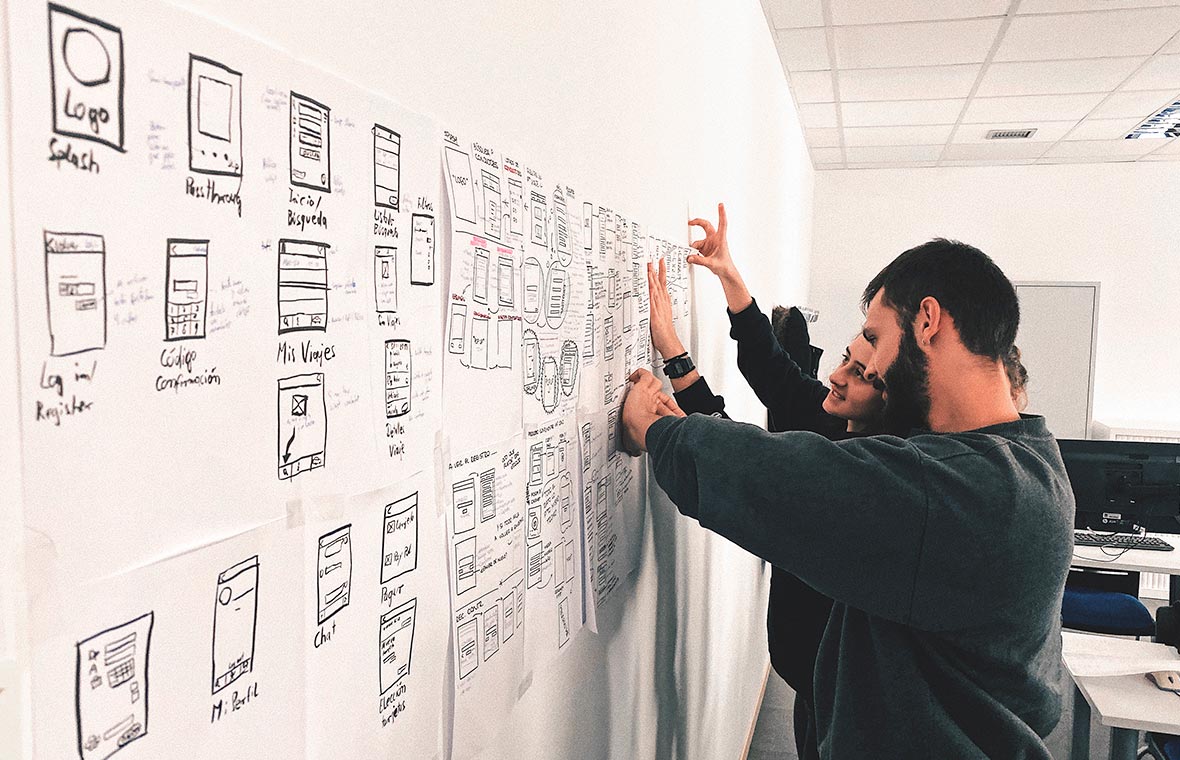Save Time and Deliver Better Web Design for Happier Clients
Working together with clients in all industries to create successful website design solutions for the last two decades has I’ve seen just about everything when it comes to creative meetings and revision requests throughout the creative process. When sitting down with a client to discuss their new website I’ve learned to approach the project a certain way from the start to avoid getting trapped in an endless feedback loop – and that’s assuming you’re just dealing with one decision maker.
One of the most important tactics I’ve learned in my web design career is how to involve decision makers in our website design and development process. In doing so, I ensure that my clients are engaged in the project right from the research phase, through strategy and eventually UI design. Many clients or small business owners often want to sign the contract and then sit back and wait for opportunities to share their opinion. This is exactly the approach I’ve learned to avoid and the reason I began experimenting with ways to include my clients in the complete web design decision making process. To make educated, effective decisions about the design of their new website people must first understand how we intended to solve the problems they’ve hired us to address. By including my clients in our research, reporting and experience design phases that lead up to the design of the new website I can explain what their analytics data is telling us and why we need to use certain best practices or strategies in the website architecture design.
This process has worked extremely well for me for the better part of the last two decades and I’ve used it many times over with single decision makers and larger groups alike.
Start With a Plan
Before you introduce your client to the project workflow be sure you are ready to address their questions and have the information and data you need to steer them back on track should they start wandering off course. Do you have a thorough understanding of their website goals? Do you have their brand kit and messaging? Do you have access to their Google Analytics data and various reports to back up your approach to solving their problems?
Most people are excited about design and the prospect of being part of the creative process, but can quickly get lost in the industry terminology and UX design process. For the most part, when I present my findings from the website analytics review and competitor SERP analysis people tend to start looking quite lost. To help avoid this situation I’ve created a questionnaire that I kick off discovery sessions with that is designed to get everyone to relax a little by answering some seemingly silly questions before we get into the fine detail. Once people have had a good laugh and let their pre-planned spiels slip out of mind we can walk through the process and what everything means. This way, I can collect the information I need to get started and deliver successful experience design solutions that meet my clients’ needs.

3 Easy Ways to Collaborate With Design Clients
Let’s look at the three main ways I run web design projects to engage my clients and encourage them to take ownership in the creative design process. Once you’ve mastered these approaches you can tailor them to make them your own and run more efficient and rewarding projects leading to happier clients.
The “20-second” Test for Visual Tolerance
This exercise is quick and relatively easy to run with one or more clients to quickly assess concept design and how it’s perceived without having to go too far down the rabbit hole.
When presenting multiple design concepts to people it’s sometimes hard to know where their visual tolerance lies. Are the web design concepts too edgy, too simple or just stray too far from their vision? Most people are not able to look at a website UI design and instantly know what they do or do not like about the concept. They may try to relay some initial thoughts, but ultimately they eventually get stuck on one or two points that are easily rectified – swapping a photo, changing a typeface, etc. – and stop looking at the design as a whole. To help guide clients and understand their visual tolerance for concept direction I’ve found that one of the best exercises for many people is the “20-second” test.
To run the test with your clients, place the initial web design concepts in front of them and ask them to rate each one on a scale of 1 to 5 (or any value you see fit to use). Ask your clients to consider the needs of the new website or business and make a quick judgement on the concept direction. Remind them that they have 20 seconds to think of or write down their score. If they want to write down any additional thoughts about each concept to support their scoring that’s even better, but limit their review time to 20 seconds.
After time runs out request that each person shares their rating and any comments that came to mind in the 20 seconds. By running this quick exercise we help clients focus on the perception or first impression of the website concepts as a whole instead of getting caught up in the little details that can easily be adjusted. Following this exercise, you will know if you’re on the right track with your conceptual work and if not, you will have some actionable feedback from which you can revise the concepts to better suit the needs of the client.
Mood Boarding
This exercise is more involved than the 20-second test and in my experience can sometimes get some pushback from clients that are not willing to put in the work to help drive the project. Don’t be afraid to remind your client that the more effort they put into discussing the project and exploring ideas during the early stages of the project will help you make more informed design decisions that will ultimately engage people on a deeper level and drive more conversions or sales for the client’s business.
If your client does not already have a brand manual or guidebook, you can have them spend a little (or a lot) of time surfing the web looking at other websites. I always recommend that my clients spend less time looking at competitors or industry websites as we don’t want to simply copy what other people have done with their UI design. The best way to mood board is to look at websites outside their industry and collect new themes and ideas. The best part is exercise does not have to be completed in one sitting either. People may browse casually on their commute, at home in the evening or on the weekend when they’re unwinding. Have them take screenshots and make notes about what they like or do not like in their findings. When all the data is collected at the end of this exercise you can assemble it into separate “Likes” and “Dislikes” groups to help guide the creative process. Seeing all this research come together helps put things into perspective for non-designers and helps make the design process more clear and ultimately rewarding for them. Many people often need this level of engagement in the design process to feel some level of ownership over the design as opposed to providing sterile feedback on nearly completed design work much later on.
The underlying goal of the mood boarding exercise is to establish alignment among website stakeholders who may have different opinions on design and user experience.

Concept or IA Sketching Session
If you’re working with a client that is really eager and willing to take a more “hands-on” approach to help make the new website a successful investment for their business schedule a concept discovery or information architecture sketching session. In this session give everyone a few pieces of blank paper and a pen or pencil. Open the conversation by reviewing the goals you have worked with them to establish for the project so they are top of mind as they stare at the blank paper in front of them. Then, instruct the client to sketch out a wireframe or information architecture that they think will help meet the website goals and achieve success. Remind them these are to be rough sketches and allow three to five minutes to explore an idea.
After time runs out, take the first sheet of paper and tuck it under the others. Re-start the clock and work on a second sketch for three to five minutes. Repeat this process a few times so that you have a series of different ideas to work from – I recommend including your own sketches in the mix as well.
Once time runs out and you have enough sketches (aim for a handful at a minimum), layout all the sketches on the table or stick them up on the whiteboard and have everyone scan through the conceptual sketches. Then, work with the client to pick and choose sketches or elements they like or feel that have some promise and begin mixing and matching ideas together. If necessary cut and paste pieces together or if you have a whiteboard or tablet, draw a new wireframe beside the hand sketches as the group collectively discusses the merits of each concept.
When working with larger groups of decision makers be prepared that this exercise may lead to differences of opinion and the potential to butt heads on some topics or ideas. This is your opportunity to record this unguarded feedback and roll it into your design work later.
Putting It All Together
I have used these methods successfully for many years to drive creative projects and get the most information I can out of clients so that I can offer the most educated information-based design work. These methods don’t work for everyone, but with a little practice, you can use these are a starting point or foundation to create your own workflow to encourage client engagement and ownership in the project. With a little experience, you may also find you will be able to take these concepts and adapt on the fly as you read the room. The trick is to try to identify which clients are willing to put in the work during the proposal stage so that you can make the most of your time and energy. No one wants to pour their heart and soul into a project that the owner cares less about than you do. Once you start making decisions based on this principle I promise you’ll have more fun creating and running design projects and your clients will respond in favour.
About Parachute Design
Since 2003, our Toronto web design company has built a reputation as an industry leader in the Toronto web design industry working with some of the world’s most exciting brands. To learn more about how we can help your business better utilize its website and digital marketing, please contact us at 416-901-8633 or complete our web design proposal planner for a free estimate.




